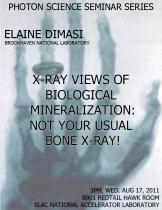Speaker: Elaine DiMasi, Brookhaven National Laboratory
Elaine DiMasi studies biological mineralization processes and crystal growth at the organic interface. Synchrotron x-ray scattering, including time resolved and in-situ measurements of mineralization, clarifies the importance of the molecular template for biominerals and gives unique access to submicron structures. Scanning probe microscopy studies of cultured cell/protein systems reveal the subtle changes in molecular architecture at very early mineralization time points. Current directions include image charge effects on protein reorganization and calcium spectroscopy at the nanoscale.
Program Description
Mineralized tissues such as bone and tooth have a mysterious origin, from a physical chemistry point of view. Classical crystallization theory concerns energetic tradeoffs in the addition of molecules or ions to the surfaces of crystal nuclei. From these considerations the formation of less stable precursor phases and the concept of Ostwald ripening emerge. However, minerals produced by cells in live tissue are likely to emerge along a significantly different path. The observation and speculation of “electron dense granules”, “x-ray amorphous mineral”, matrix vesicles, calcium phosphate “Posners clusters”, and organic-mineral clusters such as lipid-calcium phosphate complexes have been mentioned in the literature for decades. These ideas connect to current thinking from biomimetic chemistry experiments, where polymer-induced liquid precursors and prenucleation clusters have been reported. This is the backdrop for experiments using synchrotron x-rays to make new observations of biological minerals. I will briefly mention achievements at the organic interface in model systems and, in more depth, discuss Ca L-edge absorption spectroscopy performed at the nanoscale at scanning transmission x-ray micro-spectroscopy beamlines.





